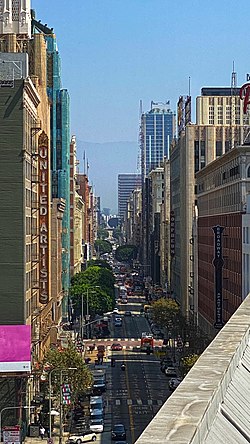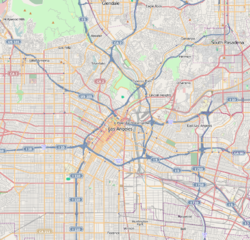 Broadway looking north from 11th Street, 2020 | |
 Interactive map of Broadway | |
| Maintained by | Local jurisdictions |
|---|---|
| Length | 17.75 mi (28.57 km) |
| Location | Los Angeles County, California, United States |
| South end | Main Street in Carson |
| Major junctions | |
| Northeast end | Mission Road in Lincoln Heights |
| Construction | |
| Inauguration | 1890 |
Broadway Theater and Commercial District (NRHP) Broadway Theater and Entertainment District (City of Los Angeles) | |
 Los Angeles Theatre on Broadway | |
| Location | 300—849 S. Broadway Los Angeles, California |
| Coordinates | 34°2′48″N118°15′4″W / 34.04667°N 118.25111°W |
| Architect | Multiple |
| Architectural style | Early Commercial, Classical Revival, Art Deco |
| NRHP reference No. | 79000484 |
| Significant dates | |
| Added to NRHP | May 9, 1979 [1] |
| Boundary increase | April 12, 2002 [2] |
Broadway is a major thoroughfare in Los Angeles County, California. The portion of Broadway from 3rd to 9th streets was Los Angeles's main commercial area from the 1910s until World War II and in 1979, it was listed as the Broadway Theater and Commercial District in the National Register of Historic Places, [1] the first and largest theater district to be listed. [3] The district was expanded to 2nd and Olympic in 2002. [2]
Contents
- Route
- History
- Founding and extension
- Commercial and entertainment center
- Decline and revitalization
- Buildings and sites
- North of Hollywood Freeway
- Hollywood Freeway to Temple
- Temple and Broadway
- First and Broadway
- Second and Broadway
- Third and Broadway
- Third to Fourth
- Fourth to Fifth
- Fifth to Sixth
- Sixth to Seventh
- Seventh to Eighth
- Eighth to Ninth
- Ninth to Olympic
- South of Olympic
- Public transportation
- See also
- References
- External links








































